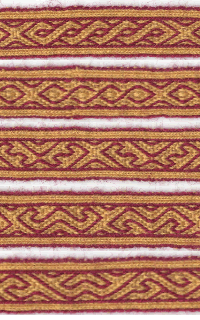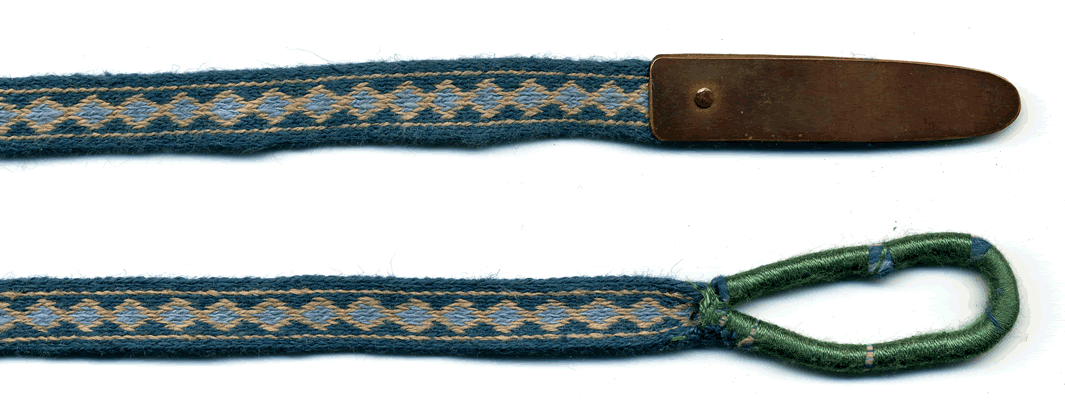Las evidencias arqueológicas más antiguas se remontan del 800 al 400 AEC en tejidos encontrados en las regiones de Alemania Suiza y Francia una pieza importante es la llamada banda de Hallstat. Mimbles Anglo Saxon diagonal Greek key pattern.

Shelagh S Website Patterns From The Past
Check out the card woven borders of Viking textiles - its how they started the spacing of a large warp.

. Twisting a tablet works by turning it around the axis that runs across from the AD edge to the BC edge of the tablet the warp threads swap from S to Z threading or vice versa and the AD and BC positions are swapped. What it is. In the article below I examine tablet weaving from a Dark Age re-enactors point of view including the history of the craft techniques motifs regional variations materials and tips to help the weaver.
The shed is opened and closed by raising and lowering the free threads. Unfortunately the pattern variations are not as numerous as in tablet weaving. About 20 twists still remain c.
Band completed 10232002 What it is This tablet woven band is woven using 18 tablets each with 4 strands of size 10 cotton crochet thread a total of 72 threads using the method described as Pack Idling by Peter Collingwood in The Techniques of Tablet Weaving using Thora Sharptooths threading sequence from her website. Threading and arrangement of tablets. It is with these thoughts that I began.
Weave by turning the odd-numbered tablets a quarter turn forwards and throwing the weft. 8 per cm in plain 4-hole weave with the twists all in the same direction S. Continental evidence can be used as guidance for Anglo-Saxon tablet weaving in this period.
Period weaving is tablet weaving. As we get further into the work you can see the twist accumulating and the tension beginning to vary even with frequent pauses to work out the twist. Ad Browse Discover Thousands of Home Garden Book Titles for Less.
Tablet weaving also known as card weaving is an ingenious technique for taking long bundles of warp threads and passing them through perforated tablets then manipulating these to make strong patterned bands. The find was dated to about 600 AD. This is one of four main tablet weaving techniques.
The warp yarn is spun lightly Z the weft is 2-ply S. Looking at the left-hand side of the pack of tablets the holes are labeled clockwise. Pattern looks good 10 into the trim.
It is a very easy way to bring color pattern and interest to your clothing. Weaving is slow but the results are pleasing. This tablet woven band is woven using 18 tablets each with 4 strands of size 10 cotton crochet thread a total of 72 threads using the method described as Pack Idling by Peter Collingwood in The Techniques of Tablet Weaving using Thora Sharptooths threading sequence from her website httpwwwcsvassareducapriestsaxontwhtml.
Samples of card woven trim by Mistress Kaleeb the Green-Eyed. These instructions describe how to weave Grace Crowfoots reconstruction of the pattern a minor variation of the same and also two motifs from the later Maaseik tablet weaving that can be woven on the same warp set. Next turn each pattern tablet 6 to 14 so that the colours are correctly oriented.
El tablet weaving o card weaving tejido por tablillas es un tipo tradicional de tejido muy popular entre los pueblos de origen germánico. Anglo-Saxon Card Weaving Late celtic Iron Age wooden cards cart find from Dejbjerg Denmark I have been interested in Card or Tablet weaving for a number of years. The tablets are small flat squares usually of bone or wood with a hole in each corner through which a warp thread is passed.
Posted on October 22 2017 April 26 2018. Pass one end of the weft through the shed which is the gap between the warp threads in the top holes of the cards and those in the bottom holes. A comparison of lucet vs.
Inkle weaving is perfectly acceptable for SCA purposes. To weave with this technique each card is normally. Turn the entire pack of cards one-quarter turn either forward away from you or backwards towards yourself.
On April 10 2015 By Sally McLean In Anglo Saxon Weaving Celtic Weaving Tablet Weaving Viking Weaving Leave a comment Tablet weaving also known as card weaving is an ingenious technique for taking long bundles of warp threads and passing them through perforated tablets then manipulating these to make strong patterned bands. The others are double- cloth weaves so-called Egyptian diagonal weaves actually used in Scandinavia in the Middle Ages 1 and single-color or other principally textural weaves. Historic techniques and patterns are different from those developed by crafts enthusiasts in the 19th and 20th centuries as they rediscovered tablet weaving.
Leave about 2 cm or so sticking out of the weft. The tablets are held in the hand like a pack of cards parallel to the warp and turned backwards or forwards by half or quarter turns. 4-strand plaiting whipcording vs.
A linen fragment was found attached to a square-headed bronze brooch in an Anglo-Saxon burial ground at Laceby Lincolnshire. For those of you who also follow me on. Tablet weaving is one of the oldest European textile techniques traceable to at least the early iron age.
The extent of tablet-weaving in the early Anglo-Saxon period on the continent at this time and in mediaeval England suggests that tablet-weaving was a popular craft at all levels of society perhaps particularly where there was a Scandinavian influence. These narrow braids could also be woven on a small vertical loom similar to those used for weaving. Tablet weaving was widespread in Europe and Britain in the first millenium AD and is an excellent.
Working out the twist is time consuming. Historically this was done with either a back strap method or a structured loom. Kempston Fragment 600s CE Found in a copper alloy box in a cemetery at a gravel quarry near Kempston Bedfordshire.
When the twill textile is raised and turned over part of a tablet-woven braid is revealed size 2-5 cm. Dark Age Tablet Weaving for Viking and Anglo-Saxon re-enactors 1 Introduction Tablet weaving also known as card weaving is a method of using square tablets with holes in the corners to weave narrow decorative bands made of wool linen or silk threads. Finger-loop braiding and the merits of the cords produced therewith.
Such a pattern may have as many different colors as there are holes in the tablets. Simple patterns are very quick and easy to get started with especially if youve done any threadwork before and understand tension. The edge of the braid is button-.
4 forward 4 backward. On an inkle weaving loom alternate warp threads are leashed to a peg whilst the others are left free - this creates the shed.

From Wulfheodenas Tablet Weaving Based Upon Sutton Hoo Braid Tablet Weaving Card Weaving Weaving Patterns

Silk Tablet Weaving Anglo Saxon Style Stock Photo Alamy

Anglo Saxon Belt Weaving Instructions
Anglo Saxon Diagonal Greek Key Tablet Weaving Doing It Wrong

Anglo Saxon 24 Tarjetas 3 Colores Repite Cada 56 Movimientos Sed 360 Disenado En Gtt Tablet Weaving Patterns Card Weaving Tablet Weaving
Anglo Saxon Threaded In Pattern Research Dumping Grounds

Anglo Saxon 4 Vevstua Bull Sveen Tablet Weaving Patterns Tablet Weaving Weaving Loom Projects

Viking Weaving Patterns Weaving Patterns Tablet Weaving Weaving
0 comments
Post a Comment